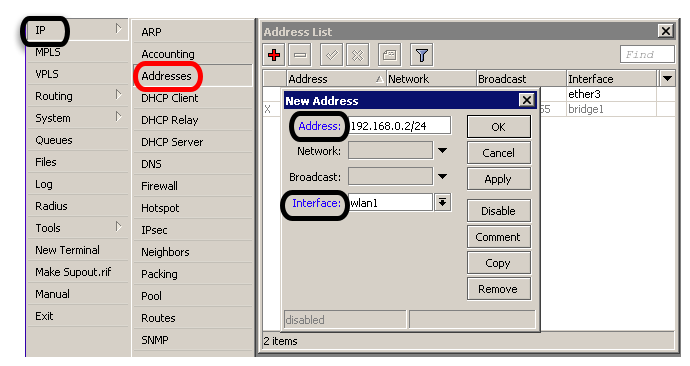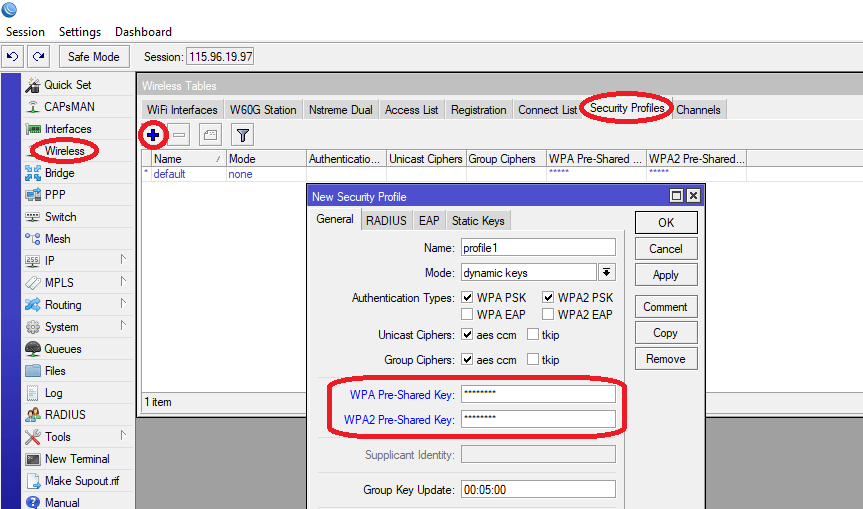

Similar to the basic-rates-b property, but used for 5ghz, 5ghz-10mhz, 5ghz-5mhz, 5ghz-turbo, 2.4ghz-b/g, 2.4ghz-onlyg, 2ghz-10mhz, 2ghz-5mhz and 2.4ghz-g-turbo bands.īasic-rates-b ( 11Mbps | 1Mbps | 2Mbps | 5.5Mbps Default: 1Mbps) Value auto equals to the value of arp-timeout in /ip settings, default is 30sīand ( 2ghz-b | 2ghz-b/g | 2ghz-b/g/n | 2ghz-onlyg | 2ghz-onlyn | 5ghz-a | 5ghz-a/n | 5ghz-onlyn | 5ghz-a/n/ac | 5ghz-onlyac | 5ghz-n/ac Default: )ĭefines set of used data rates, channel frequencies and widths.īasic-rates-a/g ( 12Mbps | 18Mbps | 24Mbps | 36Mbps | 48Mbps | 54Mbps | 6Mbps | 9Mbps Default: 6Mbps) This value is announced by AP, and can be matched in connect-list by area-prefix.Īrp ( disabled | enabled | proxy-arp | reply-only Default: enabled)Īrp-timeout ( auto | integer Default: auto)ĪRP timeout is time how long ARP record is kept in ARP table after no packets are received from IP. rxa-txb - use antenna 'b' for transmitting, antenna 'a' for receiving.txa-rxb - use antenna 'a' for transmitting, antenna 'b' for receiving.Select antenna to use for transmitting and for receiving Max frame size to allow including in AMSDU.Īntenna-gain ( integer Default: 0)Īntenna gain in dBi, used to calculate maximum transmit power according to country regulations.Īntenna-mode ( ant-a | ant-b | rxa-txb | txa-rxb Default: ) Sending and receiving AMSDUs will also increase CPU usage.Īmsdu-threshold ( integer Default: 8192) AMSDU aggregation may significantly increase throughput especially for small frames, but may increase latency in case of packet loss due to retransmission of aggregated frame.


Max AMSDU that device is allowed to prepare when negotiated. Due to this, by default AMPDUs are enabled only for best-effort traffic.Īmsdu-limit ( integer Default: 8192) Using AMPDUs will increase throughput, but may increase latency, therefore, may not be desirable for real-time traffic (voice, video). Note that no authentication is done for these clients (WEP Shared keys are not compared to anything) - they are just accepted at once (if access list allows that)Īmpdu-priorities ( list of integer Default: 0)įrame priorities for which AMPDU sending (aggregating frames and sending using block acknowledgment) should get negotiated and used. This property is only effective for cards based on Atheros chipset.Īllow WEP Shared Key clients to connect. Client/station also can operate in different modes, a complete list of supported modes can be found here.Īdaptive-noise-immunity ( ap-and-client-mode | client-mode | none Default: none) Wireless can operate in several modes: client (station), access point, wireless bridge etc. Wireless features compatibility table for different wireless protocols. RouterOS wireless comply with IEEE 802.11 standards, it provides complete support for 802.11a, 802.11b, 802.11g, 802.11n and 802.11ac as long as additional features like WPA, WEP, AES encryption, Wireless Distribution System (WDS), Dynamic Frequency selection (DFS), Virtual Access Point, Nstreme and NV2 proprietary protocols and many more. 12.4.5 Security profile and access point matching in the connect list.12.4.2 RADIUS EAP pass-through authentication.5.2.2 Disallow connections to specific access points.5.2.1 Restrict station connections only to specific access points.2.1 Transmit Power representation on 802.11n and 802.11ac.In the company network the mikrotik AP deliver a performance of around 60 MBit/s, so the mikrotik routers are not the bottle neck (at least not in AP mode). (hotel network) - wifi -> |(station 5.0 GHZ) - (NAT routing) - (AP with 2.4 GHz)| - wifi -> local device eg. (no change: still 5-10 MBit/s), Using 5 GHz to connecto the hotel (station) and 2.4 GHz as AP to connect to the local devices is even worse (2-3 MBit/s only).Ĭompared to connect the iPhone directly to the hotel network is around 50-60 MBit/s. My latest idea was a hAP AC lite (2.4 and 5 GHZ radio) to connect to the hotel network with 2.4 in station mode and local AP with 5 GHz. So I tried to replace the DIR-505 with a Mikrotik hAP (station mode), because I thought the bottle neck is the DIR-505, but no performance increase (still 5-10 MBit)

This works in general fine, but awfully slow (max. Usually I use on travels a D-Link DIR-505 (travel router) to connect to the hotel WiFi network (2.4 GHz) and connected to the DIR-505 a mAP as AP lite to spawn a local WLAN with direct VPN to the company network. I have a problem, which fits to this topic:


 0 kommentar(er)
0 kommentar(er)
